Using Compact Mass Spectrometry for Detection and Quantitation of Cannibis-Related Compounds
Special Issues
The transition of cannabis from an illegal drug to a drug for medical and even recreational use raises challenging questions for regulatory agencies and analytical chemists alike. Here, we show a selection of analytical techniques based on compact mass spectrometry in combination with three different sample inlets (atmospheric solids analysis probe), thin-layer chromatography, as well as classical liquid chromatography) for the detection and quantification of cannabinoids and pesticides in cannabis-related material and contraband.
The transition of cannabis from an illegal drug to a drug for medical and even recreational use raises challenging questions for regulatory agencies and analytical chemists alike. Here, we show a selection of analytical techniques based on compact mass spectrometry (MS) in combination with three different sample inlets (atmospheric solids analysis probe, thin-layer chromatography [TLC], and classical liquid chromatography [LC]) for the detection and quantification of cannabinoids and pesticides in cannabis-related material and contraband.
In the United States, cannabis is now on its way to become a normal crop and consequently many of the currently discussed challenges that relate to cannabis and its products have long been solved for other comparable crops. What makes cannabis unique though, and significantly more complicated, is its currently fragmented legal status as well as its various forms of consumption and aims. Is it a medicine or a recreational drug? Is it a tobacco product? Is it food? Does it have parallels to alcohol? Such questions should ultimately be answered and will dictate how it will be regulated in the marketplace and what agency should be responsible for its monitoring.
One of the issues with cannabis that is often overlooked is the changing cannabinoid make up over the last decades. Cannabis produces upward of 400 compounds (approximately 80 compounds unique to this plant) that interact to varying degrees on the natural cannabinoid receptors in the human brain as well as the nervous and immune system (the endocannabinoid system [1]). Unfortunately, cannabis strains with extremely high psychotropic tetrahydrocannabinol (THC) levels have been bred in the past for illegal recreational drug use (some reports show cannabis strains with THC content as high as 30-40% [2]). But those strains have little benefit for medicinal use because their potent psychotropic effect is undesirable for patients and because other cannabinoids, terpenes, and secondary plant metabolites such as cannabidiol (CBD) are down-regulated at the same time and these are likely much more important for medicinal effects (3,4).
Another emerging problem is the contamination of the cannabis product with pesticides. Because of its status as illegal drug on the federal level there is no United States Environmental Protection Agency (US EPA) guidance as to what pesticide can be used during the growth of the plant or what residue level would be acceptable (and monitored by the Food and Drug Administration [FDA] or the U.S. Department of Agriculture [USDA]). Consequently, it is illegal to use any pesticides on cannabis plants and it should be an organically grown product (5). However, a test analysis of a very small number of cannabis samples from dispensaries in Los Angeles, California, in 2009 showed that two out of three samples had significant levels of the insecticide bifenthrin--one sample exceeded the legal limit for an edible crop by a factor of 1600 (6).
It is noteworthy that the major consumption of cannabis is through smoking--not ingestion--and it has been shown that pesticides can pass into the mainstream smoke at rates up to 69%, depending on smoking style (filter or filterless, waterpipe and so on) (7). In other words, two of the three samples obtained in the above small-scale study would be considered a consumer health risk. This is even more concerning in light of patients with compromised immune systems taking medical cannabis to improve their health status.
Finally, it is important to note that despite changes in some states, cannabis is still an illegal drug in a majority of states and on the federal level. The challenges described above can of course be monitored with analytical chemistry workflows that satisfy the different requirements for
• simple and legally defensible cannabis detection in contraband material;
• detection of pesticides and their quantification;
• and characterization of the major cannabis components to provide adequately labeled products that informed consumers can choose from where it is legal to do so.
Here, we discuss three analytical workflows based around compact mass spectrometry (MS) with different sample inlet systems ranging from the more recent atmospheric solids analysis probe (8), a thin-layer chromatography (TLC) extraction device, and a more classical high performance liquid chromatography (HPLC) inlet to demonstrate cost effective and easy-to-use solutions for law enforcement, producers, and dispensaries of cannabis.
ExperimentalAtmospheric Solids Analysis Probe and Compact MS Analysis of Contraband Material and Surfaces of Interest
The glass capillary of the atmospheric solids analysis probe (ASAP, Advion, Inc.) was either placed into direct contact with the contraband material or rubbed over the index finger or shirt sleeve of a volunteer that had been in contact with the material. The capillary was then placed into the source housing holder with commencement of MS acquisition. The sample inlet (Figure 1) uses hot nitrogen gas to rapidly vaporize the analytes present on the tip of the glass capillary and transports the vapor stream to a corona discharge needle where molecules are ionized by atmospheric pressure chemical ionization (APCI). Ions are transferred into the MS analyzer through the inlet capillary of the mass spectrometer. With this technique the separation of analytes happens exclusively during the evaporation stage and by mass-to-charge ratio in the gas phase.
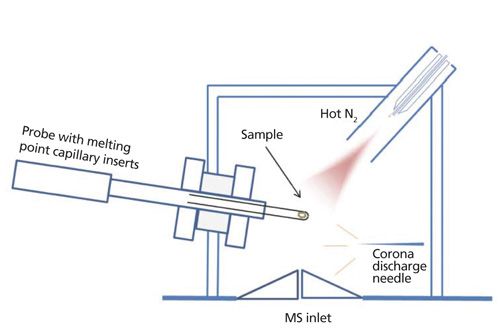
TLC and Compact MS Analysis of Cannabinoids
Cannabinoid standards and a make-up sample of a leaf extract fortified with cannabinoids were separated on TLC silica gel 60 F254 (Merck) with a developing solvent of 80:20 petroleum ether (60-80 bp)-dioxane (Sigma Aldrich). The TLC-compact MS analysis used a Plate Express (Advion, Inc.) extraction device with a 200-µL/min solvent flow of methanol-0.1 vol% formic acid and an extraction head with an area of approximately 1 mm × 2 mm.
HPLC and Compact MS Analysis of Cannabinoid and Pesticide Standards
Samples were analyzed with an Agilent model 1220 HPLC gradient system and a 100 mm × 2.1 mm Supelco Titan column (Sigma-Aldrich) at a column temperature of 50 °C, a flow rate of 250 µL/min and a 5-min gradient from 35% to 90% B. Solvent A consisted of water-0.1 vol% formic acid, and solvent B consisted of acetonitrile-0.1 vol% formic acid. For the analysis of pesticides, the gradient was adjusted to start at 10% B.
A mass range of m/z 100 to m/z 1000 was scanned using both polarity switching and in-source collision-induced dissociation (CID). Selected ion monitoring (SIM) scanning in the negative ion mode MS was used at m/z 313.2 (THC and CBD) and m/z 309.2 (CBN) for the quantitative analysis approach for cannabinoids and SIM scanning in positive ion mode was used at m/z 202.1 for carbaryl, m/z 222.1 for carbofuran, m/z 300.0 for captan, and m/z 331.1 for malathion (all compounds from Sigma-Aldrich). All MS methods used the expression CMS mass spectrometer (Advion Inc.).
Results and Discussion
The combination of the atmospheric solids analysis probe and a compact mass spectrometer (Figure 1) provides a rapid analysis system that can detect the presence of cannabis in contraband material and other surfaces of interest. Even short exposure of fingers and shirt sleeves to the contraband material during its handling provided sufficient residue of cannabinoids (Figure 2) to make successful swabs. Tests from the index finger and sleeve of a shirt (Figure 3) resulted in MS data in both negative and positive full-scan mode that showed the expected m/z signals for THC, CBD, CBN, and the acids of CBD and THC (the acids from skin were not detectable because of ion suppression, presumably from fatty acids--Figure 4). The contraband material itself resulted in very strong mass spectrometry signals at the expected m/z (data not shown). The method is therefore sufficiently sensitive and selective for rapid screening of cannabinoids present in either raw material, suspect contraband, or other forensic samples. It is noteworthy that a compact MS system can also be outfitted for transportability by applying a mobile attenuation module, which would make the compact MS system comply with MIL-STD-810 (rev G) and allow for mobile analysis systems fit for field work. The atmospheric solids analysis probe and compact MS work was executed in a United States Drug Enforcement Agency (DEA)-approved laboratory with a real life contraband sample.
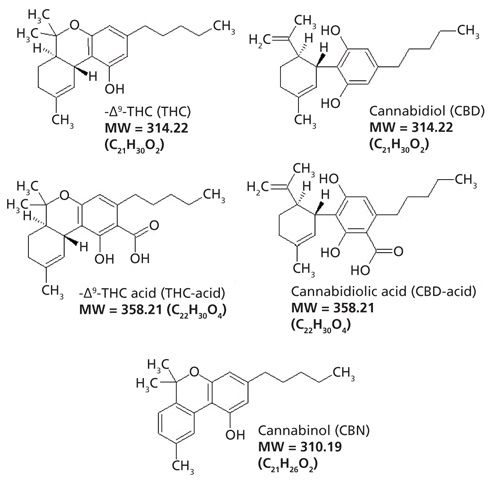
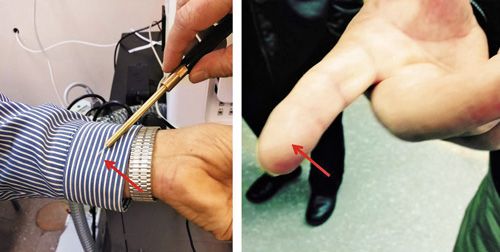
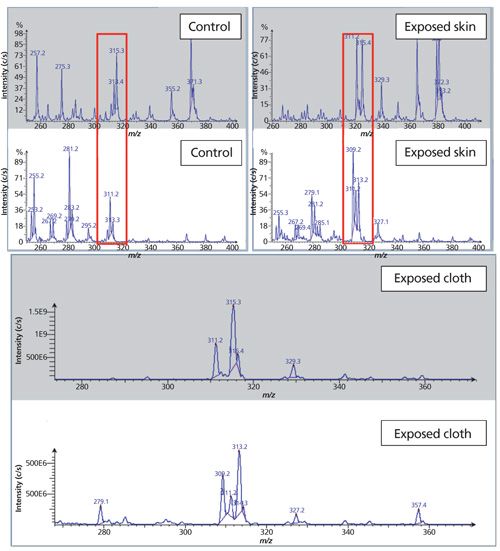
Further analysis using a simple form of chromatographic separation by thin-layer chromatography (TLC) showed that cannabinoids can be separated from each other and the matrix components (Figure 5). Using an on-line TLC extraction device, spots of interest can be transferred to the mass spectrometer for in depth interrogation, for example, Figure 6 shows the analysis of the corresponding THC spot at Rf 0.44 in negative ion mode MS with additional information by in-source fragmentation. However, THC and CBD (as well as their acids) are isobaric compounds and cannot be distinguished by mass alone. In positive ion mode ionization, even their fragmentation is identical (data not shown, compare to reference 10) and only negative ion mode fragmentation offers some distinction since CBD requires higher collisional energy to result in the same fragment ions. The advantages of a TLC and compact MS natural product analysis lie in its low cost and simple integration into standard laboratory workflows with a quick and unequivocal compound identification; however, quantification is not usually done by TLC and compact MS.
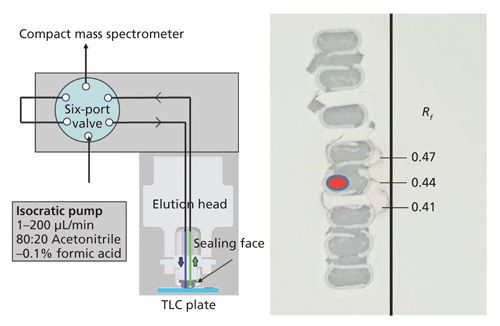
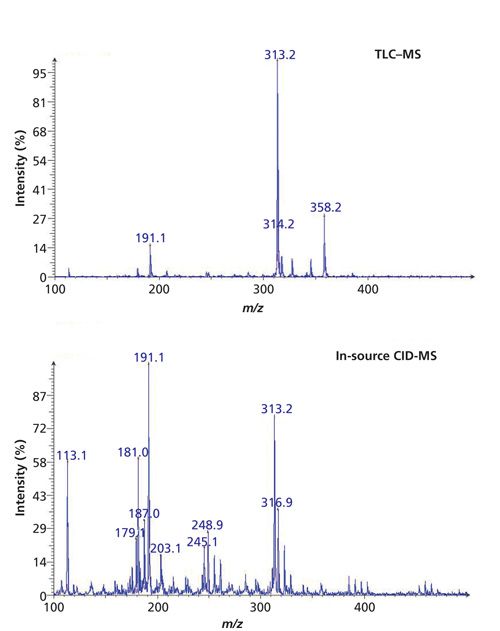
For a more detailed cannabinoid make-up analysis, a chromatographic separation was therefore used combining classical HPLC coupled with compact MS analysis. With this technique, we were able to obtain a separation of all investigated analytes either in the time or mass-to-charge domain within a 5-min gradient HPLC run. Resulting calibration functions showed a good linear correlation (Figure 7) with an assay sensitivity sufficient to identify cannabinoid components with as little as 0.1% (w/w). With the same system setup, but a slightly different gradient start point, a selection of four example pesticides can also be detected at the 10 ppm level (Figure 8), which is entirely sufficient to screen for illegal pesticide use.
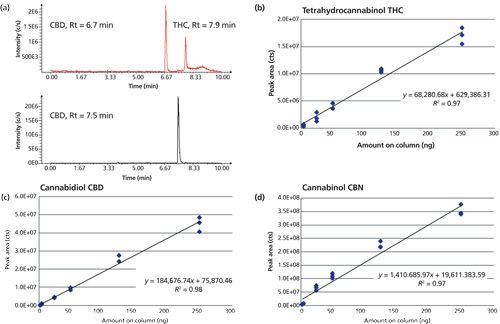
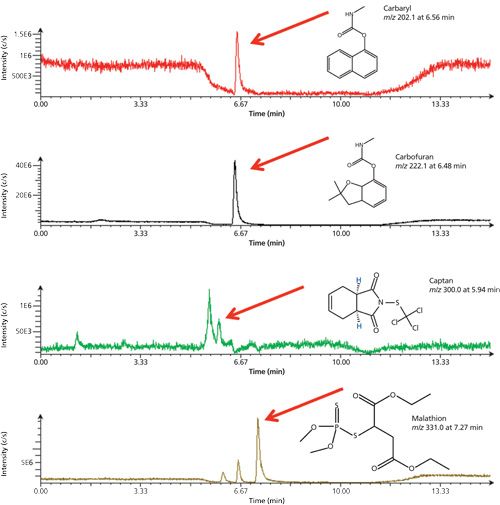
Because Advion does not have a DEA licensed facility and our home state of New York has not legalized cannabis, the TLC-compact MS and HPLC-compact MS work was carried out with analytical standards as well as maple tree leaf samples only. Typical alternatives to measure the cannabinoid make-up could use gas chromatography (GC), usually in combination with MS detection and electron impact ionization (11-13). However, these methods tend to require more extensive sample preparation and derivatization compared to LC-MS.
Conclusion
Compact mass spectrometry interfaced with suitable sample introduction techniques can be part of an efficient workflow for screening of cannabinoids in contraband materials. This approach is also amenable to the quantification of cannabinoid composition and the detection and quantification of pesticides allowing compliance with current regulatory guidelines. The approach is cost effective, easy to perform, and can be transported to the field. We suggest this approach can be useful for both law enforcement and forensic applications as well as for growers and dispensers of cannabis where it is legal. In particular, the product characterization of cannabis seems an inevitable necessity given the vast differences in cannabinoid make-up between cannabis strains and its significantly different aim (and desirable composition) between recreational and medical use. Pesticide detection is also a requirement to help characterize the origin of the cannabis material in question and should be part of the product characterization to improve consumer health protection, particularly when considering cannabis for medical use.
Acknowledgments
We would like to thank Dr. George Mailin and the Morris State College Equine Drug Testing and Research program for the opportunity to analyse authentic cannabis forensics samples in its DEA licensed facility. We also thank LuAnn Yaerik from Sigma-Supelco for the generous gift of a Titan HPLC column as well as Changtong Hao, Jamey Jones, and Amy Boardman-Lummus from Advion Inc., for their assistance during this project.
References
(1) A.A. Izzo, F. Borrelli, R. Capasso, V. DiMarzo, and R. Mechoulam, Trends Pharmacol. Sci.30(10), 515-527 (2009).
(2) A. LaFrate, “Marijuana Testing Yields Fascinating Results,” presented at the 249th National Meeting & Exposition of the American Chemical Society (ACS), Denver, Colorado, 2015, http://bit.ly/MarijuanaTestingACS.
(3) E.B. Russo, Br. J. Pharmacol. 163, 1344-1464 (2011).
(4) Understanding Medical Cannabis 2nd edition (Steep Hill Halent, Elemental Wellness, San Jose, California, 2014) https://drive.google.com/file/d/0B3DPJKkBZdbYdjh3ZDJXY1U4OWM/edit?usp=sharing/&pli=1.
(5) J. Thomson, “Medical Marijuana Cultivation and Policy Gaps,” California Research Bureau 2012.
(6) N. Skeet, “City Attorney Explains Medical Marijuana Issue on NBC,” http://lacityorgatty.blogspot.com/2009/10/city-attorneyexplains-medical.html, 2009.
(7) N. Sullivan, S. Elzinga, and J.C. Raber, Journal of Toxicology (2013) http://dx.doi.org/10.1155/2013/378168.
(8) C.N. McEwen, R.G. McKay, and B.S. Larsen, Anal. Chem. 77, 7826-7831 (2005).
(9) United Nations Office on Drugs and Crime, “Recommended Methods for the Identification and Analysis of Cannabis and Cannabis Products” (2009). Available at: https://www.unodc.org/documents/scientific/ST-NAR-40-Ebook.pdf.
(10) S. Broekner, S. Herre, and F. Pragst, Forensic Sci. Int.10(218[1-3]), 68-81 (2012).
(11) J. Omar, M. Olivares, J.M. Amigo, and N. Etxebarria, Talanta 121, 273-280 (2014).
(12) J. Omar, M. Olivares, M. Alzaga, and N. Etxebarria, J. Sep. Sci. 36(8), 1397-1404 (2013).
(13) B.K. Logan, L.E. Reinhold, A. Xu, and F.X. Diamond, J. Forensic Sci.57(5), 1168-1180 (2012).
Daniel Eikel is the product manager with Advion Inc., in Ithaca, New York. Simon J. Prosser is the vice president of marketing with Advion Inc. Jack D. Henion is the chief scientific officer with Advion Inc. Direct correspondence to: eikeld@advion.com
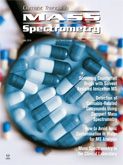
Evaluation of Modified QuEChERS for Pesticide Analysis in Cannabis
May 2nd 2017Well-established techniques used by the food safety industry, such as QuEChERS sample preparation followed by LC–MS/MS for the analysis of multiresidue pesticides, are evaluated for use with cannabis plant material.We evaluated a modified QuEChERS LC-MS/MS method for analysis of multiresidue pesticides.
Analysis of Terpenes in Cannabis Using Headspace Solid-Phase Microextraction and GC–MS
May 2nd 2017Headspace SPME combined with GC–MS for the qualitative and quantitative analysis of terpenes in cannabis offers several advantages compared to other methods. It does not require the use of organic solvents, does not coextract matrix, and provides additional means of peak identification and purity using spectral data. It is also a nondestructive method.
Pesticide and Mycotoxin Analysis: Mastering the Complexity of the Cannabis Matrix
May 1st 2017The method described here allows for the simultaneous analysis of 47 pesticides and five mycotoxins in cannabis in one simple QuEChERS procedure. This simple method is designed for implementation in start-up laboratories and in established laboratories that wish to streamline their sample preparation process, decrease solvent usage, and obtain accurate and fast results.
Evaluation of Modified QuEChERS for Pesticide Analysis in Cannabis
May 2nd 2017Well-established techniques used by the food safety industry, such as QuEChERS sample preparation followed by LC–MS/MS for the analysis of multiresidue pesticides, are evaluated for use with cannabis plant material.We evaluated a modified QuEChERS LC-MS/MS method for analysis of multiresidue pesticides.
Analysis of Terpenes in Cannabis Using Headspace Solid-Phase Microextraction and GC–MS
May 2nd 2017Headspace SPME combined with GC–MS for the qualitative and quantitative analysis of terpenes in cannabis offers several advantages compared to other methods. It does not require the use of organic solvents, does not coextract matrix, and provides additional means of peak identification and purity using spectral data. It is also a nondestructive method.
Pesticide and Mycotoxin Analysis: Mastering the Complexity of the Cannabis Matrix
May 1st 2017The method described here allows for the simultaneous analysis of 47 pesticides and five mycotoxins in cannabis in one simple QuEChERS procedure. This simple method is designed for implementation in start-up laboratories and in established laboratories that wish to streamline their sample preparation process, decrease solvent usage, and obtain accurate and fast results.
2 Commerce Drive
Cranbury, NJ 08512
All rights reserved.